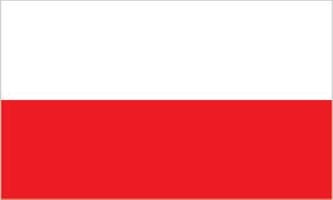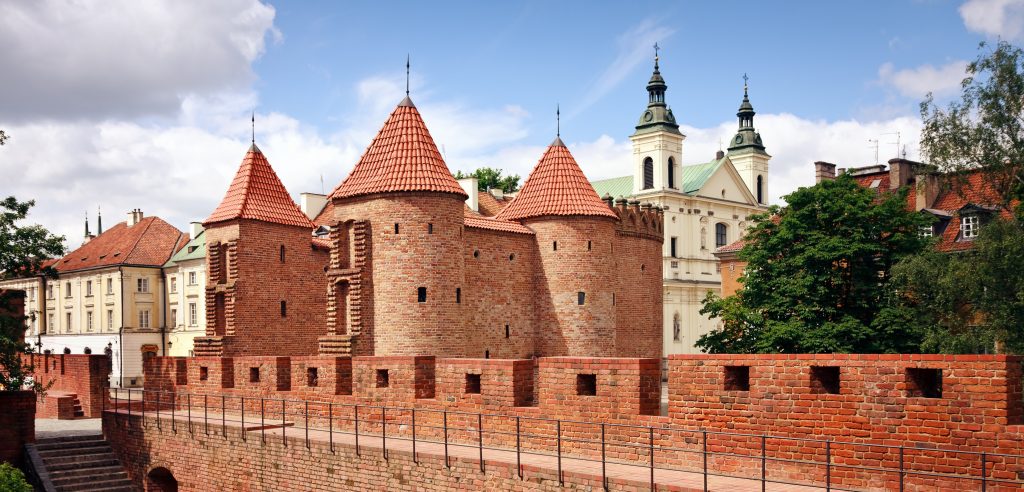
GEOGRAPHY
The majority of the area in Poland consists of lowland plains, with the exception of the Carpathian mountains in the southeast, and the Sudety mountains in southwest. These mountains create the southern border of Poland. The Baltic Sea creates the northern border. Country borders are with Germany to the west, Czechia to the southwest, Slovakia to the south, Ukraine to the southeast, Belarus to the east, Lithuania and Kaliningrad Oblast (Russian exclave) to the northeast. Northern Poland is covered with lakes, islands, canals and rivers. The northern coastline along the Baltic Sea is over 300 miles of beaches, cliffs and inlets.
HISTORY

Poland first became a state in the 10th century, and by the 16th century, established the Polish-Lithuanian Commonwealth, which controlled a large region in Central and Eastern Europe. Poland faced governmental struggles from within which slowly began to weaken the country during the 18th century. Between 1772 and 1775, Poland was divided up between Russia, Prussia and Austria. Poland did become independent again in 1918 but only lasted until World War II when Germany and the Soviets took control of the area. After Germany invaded Poland, the Soviets invaded eastern Poland. In 1941, when Germany invaded the Soviet Union, they gained control of all of Poland. The Poles were now in exile and formed their own underground armies to rebel against the Germans. These soldiers fought under the direction of the Soviet and British armies. In 1943, the Poles requested an investigation of mass graves of Polish soldiers killed by the Soviets. Although Poland was considered independent after the war, its military and government were still heavily influenced by the Soviets. In the following years, reforms were made to the communist regime in Poland, but the country struggled with many economic hardships. In 1980, workers on strike reached an agreement with the government giving workers the right to create trade unions and a movement known as “Solidarity” grew larger in the country. The Solidarity movement gained control of the presidency after elections in 1989 and 1990 which brought an end to the communist party and the creation of a free-market, renaming the country the Republic of Poland. Since the 1990’s and on, Poland has made great strides in reaching a democracy.
THE PEOPLE
Almost 100 percent of the population is Polish and most are Roman Catholic. Prior to World War II, Poland was a little more mixed with other ethnic groups. The majority of the Jewish population was killed during the German occupation and the remainder, including many other ethnic groups, began emigrating out of the country.
SOCIAL CONVENTIONS
People are generally friendly and welcoming to travelers. Removing your shoes before entering a house is common. Smoking is prohibited in most public areas including bars and restaurants. Be aware that for some people religion is taken very serious, especially among traditional conservatives in rural areas. It may me taken as highly disrespectful to joke about ones religious beliefs. Casual clothing that leans a little conservative is acceptable in most places. Formal attire may be required for more upscale restaurants and for certain types of evening entertainment.
LANGUAGES
Polish is the official language spoken by most people. English, Russian and German may be spoken by some.
GOVERNMENT
Parliamentary Republic
TIME ZONE
UTC +1 (observes summer daylight savings time)
ELECTRICITY
230V supply voltage and 50Hz
Plugs and Sockets Type C & E
CLIMATE
With a continental European climate, Poland’s winters can be moderately severe with lots of snow expected during the months between December and March. Spring and autumn are mostly cold with cloud cover and rain. Summers are mild with frequent showers and thundershowers.
Clothes to Wear:
It can rain throughout the year, so you may want a light rain coat. We usually don’t recommend traveling long distances with an umbrella. If you feel you need an umbrella, rather purchase one overseas. It is recommended to bring light to medium weight clothing in the summer and medium to heavy weight clothing for the winter. Pack some warm layered clothing, a coat, gloves, warm hat and scarf. Even in the summer months of June, July and August, it can be cool some days and in the evenings. Clever layering is the key to dressing for changeable weather.
LOGISTICAL
Entry & Exit Requirements:
Poland is a party to the Schengen Agreement. This means that U.S. citizens may enter Poland for up to 90 days for tourist or business purposes without a visa. Your passport should be valid for at least three months beyond the period of stay in Poland. You need to show sufficient funds and a return airline ticket. Visit the Embassy of Lithuania website for the most current visa information. For US and Canadian residents who are not U.S. or Canadian citizens (green-card-holders) with foreign passports please consult https://www.schengenvisainfo.com/ for correct European Union visa rules.
If you are transiting Poland en route to other countries, know all entry and exit requirements for your final destination. You may be denied boarding for your connecting flight if you have incorrect documentation or not enough validity on your U.S. passport beyond the planned stay in your destination country. If you are denied boarding, you will need sufficient funds and a return airline ticket or an itinerary that does not require entry into the Schengen zone.
- Passports must have at least three months remaining validity beyond your date of planned departure from Poland. If you travel to and from Poland to other Schengen countries, it is recommended you have at least six months remaining validity on your U.S. passport beyond departure from the Schengen area. Air travelers to Poland may be denied boarding if their passports lack this remaining validity.
- Polish citizens (including U.S.-Polish dual nationals or those with claims to Polish citizenship) must enter and depart Poland using a Polish passport. Dual nationals who entered Poland only with a U.S. passport, especially those who stayed in Poland over 90 days, may be unable to depart Poland until they obtain a Polish passport.
- You need a visa for stays longer than 90 days or to work or study in Poland.
- Non-EU visitors must obtain a stamp in their passport upon initial entry into a Schengen country in order to depart the Schengen area without difficulty.
For further information on entry requirements and current visa information, please contact the consular section of the Embassy of Poland, 2224 Wyoming Avenue, N.W., Washington, D.C. 20008, (202) 499-1700, or a Polish consulate in Chicago, Los Angeles, New York, or Houston.
The U.S. Department of State is unaware of any HIV/AIDS entry restrictions for visitors to or foreign residents of Poland.
Embassy Locations:
U.S. Embassy Warsaw
Aleje Ujazdowskie 29/31
00-540 Warsaw, Poland
Telephone: +48 (22) 504-2000
American Citizen Services: +48 (22) 504-2784
Emergency After-Hours Telephone: +48 (22) 504-2000
Fax: +(48) (22) 504-2088
Email: ACSWarsaw@state.gov
Canada Embassy Warsaw
Jana Matejki 1/5,
00-481, Warsaw, Poland
Telephone: 48 (22) 584-3100
Fax: 48 (22) 584-3192
Email: wsaw@international.gc.ca
Health:
Adequate medical care is available, but the quality of hospital facilities and nursing support may not be comparable to U.S. standards in all regions of Poland. Emergency services may be lacking in small towns and rural areas. Physicians are generally well-trained, and many doctors speak English (nurses and staff may not). While medication and treatment is generally substantially less-costly than in the United States, doctors and hospitals often expect cash payment prior to treatment. Medication, while generally available, may not be U.S. brand-name drugs.
We do not pay medical bills, and U.S. Medicare is not valid overseas.
Medical Insurance: Make sure your health insurance plan provides coverage overseas. Most care providers in Poland accept cash and credit card payments prior to service.
We strongly recommend supplemental insurance to cover medical evacuation.
If traveling with prescription medication, check with the Polish Ministry of Foreign Affairs to ensure the medication is legal in Poland. Always, carry your prescription medication in original packaging with your doctor’s prescription.
Vaccinations: Be up-to-date on all vaccinations recommended by the U.S. Centers for Disease Control and Prevention.
Information on vaccinations and other health precautions, such as safe food and water precautions and insect bite protection, may be obtained from the Centers for Disease Control and Prevention’s (CDC) hotline for international travelers at 1-800-CDC-INFO (1-800-232-4636) or via the CDC website at http://wwwnc.cdc.gov/travel. For information about outbreaks of infectious diseases abroad, consult the infectious diseases section of the World Health Organization (WHO) website at http://www.who.int/topics/infectious_ diseases/en/.The WHO website also contains additional health information for travelers, including detailed country-specific health information.
BANKS & CURRENCY
Banking hours are Mon-Fri 9:00am to 4:00pm and Saturday 9:00am to 1:00pm.
Currency is zloty (zl).
COMMUNICATION
Country code: 48
Internet country code: .pl
Cell Phone Usage:
Please contact your cell phone provider to determine whether your contract includes coverage in the country you are visiting. Depending on your contract you may have to add international services and/or country specific services.
ENTERTAINMENT
Food & Drink:
Most meals contain soup, fish or meat, and potatoes. Pork is usually the choice of meat over beef. Cakes and pastries are of high quality in Poland. International cuisine can be found in major cities such as Warsaw, Gdansk and Cracow. Vodka is the country’s most popular alcohol and a variety of types can be found in the country. Other dishes found in Poland include:
- Uszka – a type of ravioli
- Pierogi – dumplings with cream cheese and potatoes
- Bigos – sauerkraut, sausage, mushroom, cabbage
- Kielbasa – Polish sausage
Nightlife:
Nightlife in Poland is vibrant with lots of activities from bars and nightclubs to cinemas and theatres. There’s a variety of music in Poland that can be found at various nightclubs including jazz, rock, pop and Polish hip-hop. Polish beer and vodka are consumed in large amounts at local bars. The best places for nightclubs are in the big cities including Warsaw, Cracow, Gdansk and Wroclaw.
Shopping:
Most stores are open between the hours of 10:00am and 7:00pm Mon-Fri. Shops may close a few hours earlier on Saturday. Various handicrafts are popular items to shop for. Traditional department store shopping is available in larger cities including Warsaw and Cracow.
BAGGAGE
Baggage rules for international and domestic air travel have changed much in recent years, differ from carrier to carrier and these days even may cover your on-board bags. Checking luggage may cost a separate fee or may be free depending on your personal status with the carrier. We therefore encourage you to read your ticket’s small print and/or contact your carrier for exact rules.
TIPPING
Most restaurants and bars already include a 10% service charge in the bill. It is customary to leave a bit extra for good service. When the service charge is not included in the bill, 10-15% is the general rule. Tips are not expected by taxi drivers, although most people tell the driver to keep the change. Airport and hotel porters should receive the equivalent of US$ 1.00 per bag.
LAUNDRY
Most hotels will arrange affordable laundry services for guests.
PHOTOS & VIDEOS
In some countries you must refrain from photographing sites such as Military bases and industrial installations. Also be aware of cultural sensitivities when taking pictures of or near churches and other religious sites. It is always courteous to ask for permission before taking photographs of people.
USE OF DRONES
The use of drones is being legislated by many countries. In some cases, drones are already forbidden, and their unauthorized use may carry severe penalties. If you plan to travel with a drone, please contact the embassy or consulate of the country you wish to visit.
![SITA Canada Final_color [Converted]new_for_wp SITA Canada Final_color [Converted]new_for_wp](https://sitatourscanada.com/wp-content/uploads/2019/12/SITA-Canada-Final_color-Convertednew_for_wp.png)
